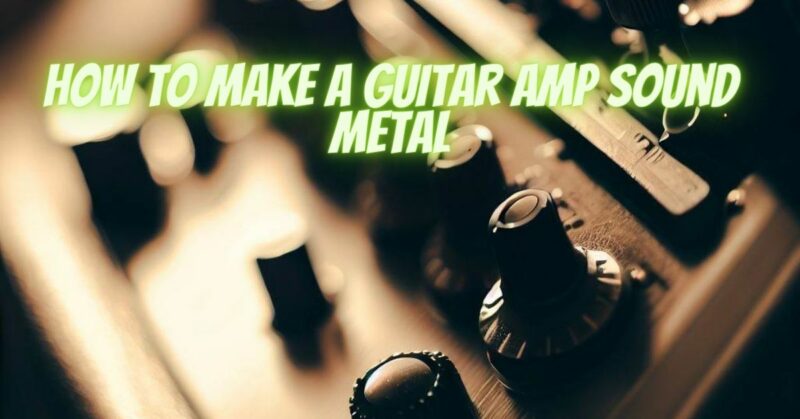Achieving a heavy and aggressive metal tone on your guitar amp involves specific techniques and settings that emphasize distortion, sustain, and a powerful sound. Whether you’re playing rhythm or lead guitar, there are several steps you can take to make your amp sound perfect for metal. In this article, we’ll explore tips and techniques to help you achieve that crushing metal tone.
- Use High Gain Settings: To achieve a heavy metal sound, start by increasing the gain or distortion on your amp. Crank it up to get a thick and saturated tone that provides the foundation for a metal sound. Experiment with different gain levels to find the right balance between clarity and aggression.
- Dial in the Equalization (EQ): Utilize the EQ controls on your amp to shape your tone. Boost the mids to cut through the mix and provide definition to your riffs. Scoop the mids for a more aggressive, modern metal tone. Enhance the bass for a heavier, thunderous sound, but be careful not to muddy up the mix. Adjust the treble to add brightness and clarity to your tone.
- Experiment with Preamp Tubes: If your amp has tube-driven preamp sections, swapping out the tubes can have a significant impact on your metal tone. Look for tubes known for their high gain and distortion characteristics, such as 12AX7 or 12AT7 tubes. Consult with a knowledgeable technician or guitarist for recommendations based on your specific amp model.
- Use Distortion and Overdrive Pedals: Consider adding distortion and overdrive pedals to your setup. These pedals can further enhance the gain and saturation of your amp, allowing you to achieve a more aggressive and defined metal sound. Experiment with different pedal combinations to find the right tone for your playing style.
- Fine-tune the Presence Control: The presence control on your amp can affect the high-frequency response of your tone. Increasing the presence can add brightness and cut to your sound, making it more suitable for metal. However, be mindful of not going too far and causing excessive harshness or sibilance. Adjust the presence control to find the sweet spot that suits your preferences and the characteristics of your amp.
- Utilize Power Attenuation: If your amp has a power attenuation feature, such as a master volume control or power scaling, experiment with lowering the power level. This can help you achieve power tube saturation and compression at lower volume levels, allowing you to crank up the gain without overpowering the room or your bandmates.
- Consider Cabinet and Speaker Selection: The choice of cabinet and speaker can significantly impact your metal tone. Look for cabinets with larger speakers, such as 12-inch or 15-inch, to deliver a more substantial low-end response. Consider speakers known for their ability to handle high gain and deliver tight and punchy tones.
- Experiment with Mic Placement: If you’re using a microphone to amplify your guitar amp, experiment with mic placement to capture the desired tone. Placing the mic close to the speaker cone can provide a more aggressive and focused sound. Experiment with off-axis positioning or using multiple mics to capture different tonal characteristics.
- Explore Guitar Pickup Selection: The choice of guitar pickups can influence the overall tone and response of your amp. Look for high-output pickups, such as humbuckers, to drive the amp harder and achieve a heavier sound. Consider pickups designed specifically for metal genres, as they often offer increased output and aggressive tonal characteristics.
- Experiment and Refine: Remember, achieving the perfect metal tone is a process of experimentation and refinement. Take the time to explore different settings, pedal combinations, and guitar techniques. Listen critically to your sound and make adjustments as needed. Don’t be afraid to think outside the box and try unconventional approaches to achieve your desired metal tone.
Conclusion:
Creating a killer metal tone on your guitar amp requires careful attention to settings, gear selection, and experimentation. By increasing the gain, shaping the EQ, utilizing distortion and overdrive pedals, and fine-tuning controls like presence, power attenuation, and mic placement, you can achieve a powerful and aggressive metal sound. Remember to explore different options and be patient in your quest for the perfect tone. With dedication and a little creativity, you’ll be shredding with a bone-crushing metal tone in no time.


